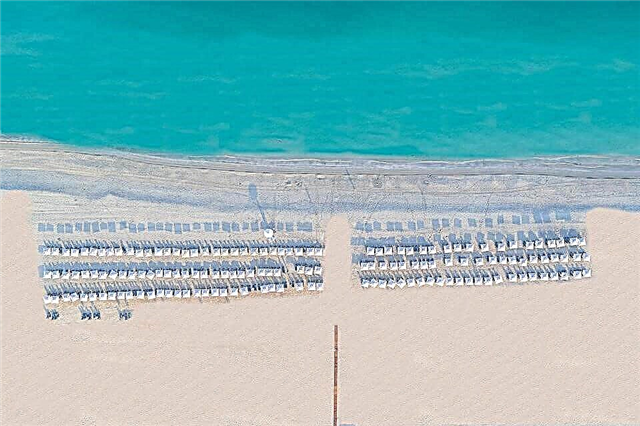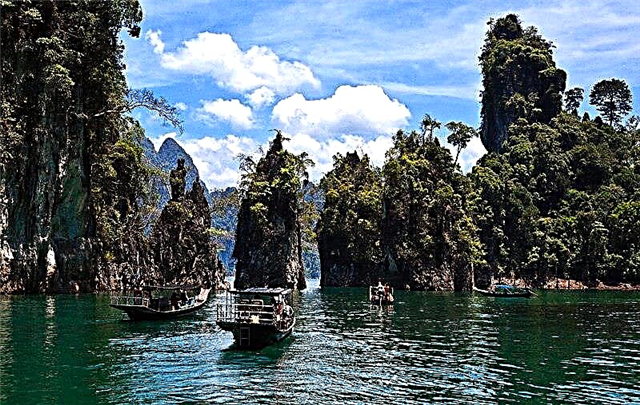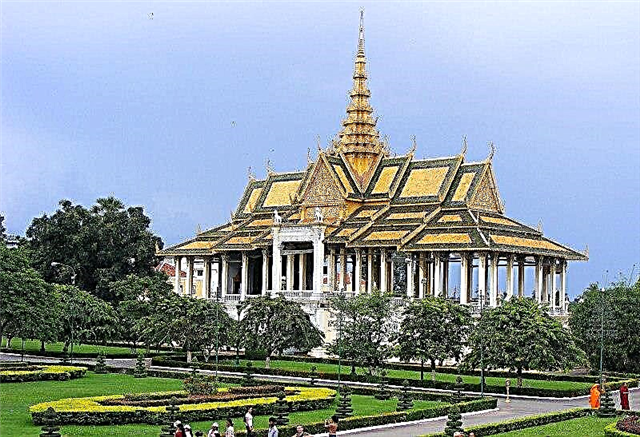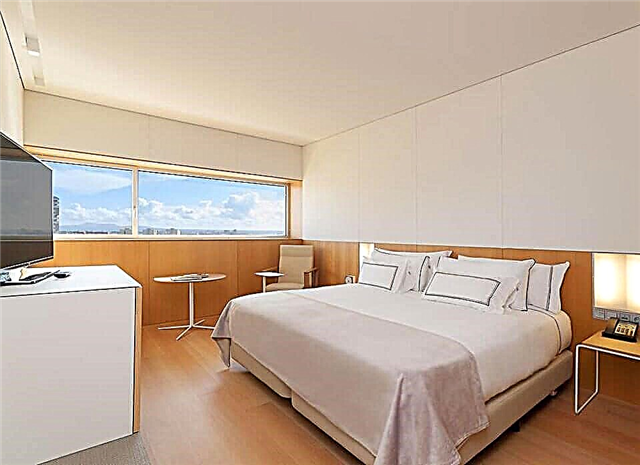The palace ensemble of Peterhof delights and surprises - it is not for nothing that it is called the world capital of fountains. This is one of the most beautiful summer residences of monarchs, and more than four million tourists come to admire its beauty every year.
History of creation
After a trip to Europe, Peter I decided to build an imperial residence so that it surpassed Versailles in beauty and grandeur. This is how the formation of the palace complex began, which became a favorite vacation spot for the royal family in the summer. Peterhof was not chosen by chance - the proximity of the bay made it possible to supply uninterrupted water for hydraulic structures.
In 1714, the Grand Palace was built, by the summer of 1723, when the grand opening of the ensemble took place, there were already Monplaisir, Marly, the Marlinsky cascade. In the following centuries, construction continued. After the October Revolution, all buildings were transferred to state ownership and open to all comers. During the war, the GMZ was badly damaged, only 50 statues and about 9 thousand units of the interior of the premises were saved.
The restoration began even before the end of the war - in 1945 the Lower Park was opened, a year later fountains began to work, including the "Samson", which was lost during the occupation. The famous buildings are being restored - Bolshoi, Monplaisir, Marly and others.
Great Peterhof Palace

Under Peter Alekseevich, it was a simple two-story building, which was called the Nagorny Chambers, here they received guests and organized holidays. In 1732, a gallery was added, but the building was still too modest in comparison with the luxury and splendor of the Russian court, it was decided to completely rebuild it. The work was entrusted to FB Rastrelli, the task was not easy - to preserve the walls erected in Peter's time and create a magnificent palazzo in the Baroque style.
The architect's talent made it possible to brilliantly fulfill the order. Rastrelli added another floor. The space in the center has increased, to which one-story galleries have joined, ending in side (Church and Corps under the coat of arms) buildings. The interior was striking in its luxury with carved gilded ceilings and huge mirrors that multiply the space. The oak cabinet of Peter the Great was preserved as a relic.
The new classic style, which has come into fashion, is making its own adjustments - by order of Catherine II, the interior of the premises is being remodeled. During the reign of Nicholas I, the third floor was built in the eastern wing, equipping the premises for Olga, the emperor's daughter. During the occupation, everything was completely destroyed, but by the spring of 1964, visitors were able to see the splendor of the first revived halls, filled with pieces of furniture, sculptures, paintings and other masterpieces of decorative and applied art. The appearance has been forming for a century and a half, now it dominates the ensemble, linking parts of the park.
The grand cascade

It is the dominant hydraulic structure, which is difficult to find equal in luxury, expressiveness and technical characteristics, one of the largest in the world. The complex of the Big (Upper) Cascade has a beautiful outer 42-meter part and an underground one located below, where grottoes are arranged.
It includes over 250 bronze sculptures, two grottoes, three waterfall stairs and many decorative details. On the terrace of the grotto, surrounded by a white marble balustrade, you can see images of tritons, Bacchus and Neptune, in niches - busts, allegorical embodiment of the seasons.
Upper garden
The 15-hectare garden is considered the main entrance to the residence. The layout, made according to the sketch of Peter I, almost did not change over time. Even during the life of the monarch, there were vegetable gardens on which vegetables and herbs were grown. Under Elizaveta Petrovna, the territory takes on a ceremonial appearance - gardens are replaced with gazebos, benches and sculptures. Later, the territory was expanded, surrounded by a fence, and a gate with wrought iron sections was installed at the entrance.
Now there are three pools, on the sides of the parterre - Square Ponds and six bosquets (an element of landscape design - trees or bushes that create compositions thanks to a decorative haircut). Clear geometry and perfect symmetry are created by straight linden alleys, lawns, trees trimmed in the form of cones or balls. Along the alleys and in the pool, statues are a must in regular gardens. A comprehensive restoration was carried out in the 1960s.
Lower park

It was created as a regular park in the image of the French, and is divided into the Parade, Marlin and Monplaisir parts. It stretches for 2.5 km along the coast of the bay, from south to north - for 0.5 km. It is an elongated triangle with an area of more than 100 hectares, the basis of the layout is a system of alleys fan-shaped from the Bolshoi and Marly palaces. Each hill is equipped with cascades - "Bolshoi", "Chess", "Golden Mountain" and "Lion", more than 150 fountains.
Voronikhinsky colonnades

The Voronikhinsky colonnades are of great importance in the planning. They close the parterres located in front of the Grand Palace, transferring the attention of visitors to the entrance to the Sea Canal. Even during the life of Peter I, there were galleries with pavilions here, by 1803 the buildings were dilapidated, fell into disrepair and were dismantled. In place of the pavilions, colonnades of granite, stone and brick were erected. At the entrance there are granite lions, flowerpots on gilded domes and flat roofs. The colonnade is named after A.N. Voronikhin. This man was a serf, but for this project he received the title of architect. General reconstruction was carried out in 1960
Museums
There are a lot of interesting and informative compositions on the territory of the park ensemble, which you should familiarize yourself with.
"Church building"
It was built in 1745, consecrated - in 1751. Here the monarchs got married, baptized children, held church services. The interior of the church is magnificent - the iconostasis of six tiers is decorated with twisted columns, the crown of the emperor and the monogram of Empress Elizabeth. The wall carvings are covered with gold leaf. The walls, ceiling and dome are decorated with biblical paintings.
The grand opening, which took place in 2011, marked the end of many years of painstaking work to restore the temple. The exposition presents items of church utensils, vestments of priests and other unique items.
"Special pantry"
It is located in the western wing of the Grand Palace. Here are items that belonged to members of the imperial family. Of particular interest are jewelry that representatives of the royal family ordered as gifts - snuff boxes, eggs, cups, rings with an imperial monogram, and other significant exhibits related to Russian history.
Historical and cultural project "Sovereigns of Fun"

The project "Sovereign Fun" was presented in 2003. Each of the nine rooms is dedicated to various imperial leisure activities. Among the exhibits, things that Peter the Great used are of great interest - these are navigation devices, measuring equipment, theatrical costumes of the 18th century, a collection of old imperial bicycles. The project uses modern multimedia technologies, which helps visitors to more clearly and easily reveal the uniqueness and historical significance of the exhibits.
Museum "Catherine's Corps"
"Catherine's Corps" (1746-1759) - was built by order of Elizabeth Petrovna. It was assumed that this would be a ceremonial palace for receiving the highest persons, for holding masquerades, balls and festive dinners.The future Tsarina Catherine the Great came here secretly from St. Petersburg to carry out a palace coup, which, as you know, ended with the overthrow of the legitimate Tsar Pavel Petrovich. Therefore, the building is named "Catherine".
The halls display personal belongings of the Russian imperial Romanov dynasty - rarities made of bronze, porcelain, wood and gold: clocks and candelabra, furniture and chandeliers, figurines and vases. Among them is a unique Russian service of 4500 items.
Museum "Bath building"

"Bath building" (1866) - was built for the wife of Alexander II, who was often ill and the doctor advised her to take a contrast shower. All baths, showers and pools are decorated with floral designs that harmonize perfectly with the classic furnishings, creating an atmosphere of tranquility.
In addition, special lounges were provided.
Collectors Museum
The "Collectors" museum composition was opened in 2002. Located in a historic three-storey building designed by Rastrelli. The basis is the gift presented by St. Petersburg collectors - canvases by famous artists, both Russian and French, Italian masters, as well as masterpieces of applied art.
In addition, there are several small collections from Moscow collectors. The upper floor is occupied by the funds of the State Museum of Fine Arts and restoration workshops, in the basement there is a restaurant. It was created in a short time - in just two years.
Benois family museum
The Benois Family Museum was opened on September 27, 1988 in the building of the Freilin House. Created at the suggestion of the artist of the Teatro alla Scala in Italy, N. Benois, who presented paintings and graphic works, sculptures and architectural models, rare photographs and authentic things belonging to the family. Benoit is a dynasty of creative talented people who have made a worthy contribution to the development of art. In total, the collection contains more than 700 works.
Monplaisir Palace

Monplaisir - (1714-1723) is located near the bay, from here you could see all the passing ships. In order for the architects to understand the task more clearly, the emperor made several drawings and drawings with his own hand. "Monplaisir" - from French "my pleasure". The emperor was very fond of this small building, investing a lot of time and soul in the construction, giving clear instructions on the layout of the halls and the design of the surrounding area. Construction ended in 1723, after the end of the war with the Swedes. It is considered a masterpiece of architectural construction of the early 18th century.
Pavilion "Hermitage"
"Hermitage" (1721 - 1725) - means "hermit's hut". The pavilion includes a vestibule decorated with pilasters, a kitchen with a fireplace, a dining room with a table with a lifting mechanism. On the second floor was the Grand Hall for the reception of guests, decorated with oak panels and paintings. Dinners and negotiations of the emperors with the guests were held in the hall. The Hermitage was actually a secluded place - a moat was dug along the perimeter of the pavilion, filled with water from the Marlinsky pond. In 1724, a drawbridge and wrought iron bars were installed on the windows.
Marly Palace

Marley was erected in 1720-1723, it is an elegant and light structure. The modern exposition includes a naval overcoat and caftan of Peter I, personal books, a table with a "slate board" made by the monarch's hands, dishes that he used, flasks made of brown glass. You can also see the collection of paintings. There are authentic furnishings, others are carefully chosen in style.
Museum "Grottoes of the Grand Cascade"

"The grottoes of the Grand Cascade" (1716-1720). The cladding was mainly tuff. The facade of the Upper Grotto is equipped with five arches with mascarons, a terrace is located on top. The grottoes are separated by a marble balustrade on which there are two bronze sculptures of Triton. The small grotto is a huge room with a high ceiling, where copies of antique statues and original works of Pietro Baratta, an Italian master, are placed. At the crossing, guests can see the brickwork, preserved from the time of Peter Alekseevich, the scheme of the water conduit and the pipes of the cascade.
Museum of fountain business
The exposition of "Fountain Business" began work in 2013 and is dedicated to the creation and development of the Peterhof water supply system. The display of the exhibits takes place together with the use of modern multimedia means. The interactive diagram of the water conduit allows viewers to learn about all stages of the creation of fountain equipment from the day of the construction of the ensemble. You can also see images of buildings, details of the first water equipment, tools and other interesting exhibits that have not survived to this day.
Museum "Imperial Yachts"

"Imperial Yachts" (2004) - the exhibition tells about the history of the yacht fleet of Russian monarchs. The collection exhibits unique photographs of sailors and yachts, dishes used during the voyage, instruments and interior details. Shown here are yacht models dating back to the times of Peter the Great. A lot is connected with Peter the Great here, it is known how he loved the sea and naval business, for example, you can see the model of the famous boat made by the emperor. The attention of visitors is traditionally attracted by the yacht "Shtandart" owned by Nicholas II. A super-modern vessel for that time, capable of going out into the open ocean.
Playing Cards Museum

The only collection of playing cards in Russia can be viewed in the Cavalier House of the late 18th century. In addition to cards, there are art objects that tell about the game of cards, and a unique library with a corresponding theme. Today, visitors are presented with various cards produced in all parts of the world - for fortune telling, in gift execution, educational. More than 8 thousand exhibits in total.
Fountains of the Upper Garden
- Not far from the Armorial and Church wings, there are Square (western and eastern) ponds. Contrary to the name, they have a rectangular shape - 54 by 45 meters. Built in 1721 as water reservoirs by order of Peter Alekseevich.
The group "Diana under the tree" was placed in the western pond, the statues of Alpheus and Proserpina are located in the east. Small statues of dolphins are located around them. In 1773, the central figures were replaced with simple fountain jets of water. At the beginning of the 20th century, compositions appeared - Spring and Summer.
- "Mezheumny" means "undefined". It is so ironically named due to the frequently changing decor.
Initially, in 1738, a sculptural group "Andromeda" was installed in a round pool, soon only the figure of a snake remained, and after a while an image of the "Sterlet" appeared. The decoration has changed several times. Now it is a composition with a winged dragon surrounded by four dolphins.
- "Dubovy" was built in 1734, the first in the Upper Garden. It originally included images of an oak tree, six dolphins and three newts cast from lead.
In 1946 it was moved to the lower part of the park, where it is still located. The sculpture "Cupid" is installed in the center. Bronze dolphins are located around the central figure, on stone beams that fan out from the middle.
The scenery was changed several times, but the original name traditionally remains the same.
- "Neptune" is the main and most magnificent building of this part of the territory.
A sculpture of Neptune with a trident is installed on a granite pedestal in the middle of a rectangular pond. It is surrounded by dolphins, newts, fantastic sea horses carrying riders, and other monsters of the ocean. River nymphs sit on both sides with oars in their hands. The pedestal is decorated with corals, bas-reliefs and bronze figures of a boy and a girl.
Neptune was built in 1736. The first option is the "Neptunovaya Cart" in the center of the pool, cast from lead, later replaced by a modern composition.
Fountains of the Lower Garden
- Samson Breaking the Lion's Jaws is a sculptural group that symbolizes the power of Russia.

In 1734 g.Empress Anna Ioanovna proposed to build it in honor of the anniversary of Russia's victory in the Battle of Poltava. As the central image, they took Samson the Stranger - the patron saint of the poor and a skilled healer. Probably because the battle, significant for the Russian state, took place on the saint's memorial day. Samson defeats the lion, which was the symbol of Sweden. The original sculpture was cast in lead in 1735. By the beginning of the 19th century. it fell into disrepair, in 1801 a new one was made of bronze.
- The mechanical fountain with an interesting shape "Sun" was built in 1721 - 1724. It is located in a large rectangular reservoir. A water wheel is hidden in the pedestal, as a result the disc of the "sun" rotates slowly.
- "Roman" - fountains are so named because they look like stone water cannons installed in one of the squares of Rome. They belong to the two-tiered type, common in the 18th century.
- The high-water "Pyramid" is located in the middle of the pool measuring 11 by 11 meters. It is a four-sided water figure. Releases 505 fountain jets, creating a water cloud in the form of a cascade.
- Crackers - their difference is in the original design and the unexpected appearance and direction of fountain jets, especially loved by children. Among them are "Dubok", "Fir-trees", "Water road" and others.
Opening and closing fountains
In 2018, the fountains will be launched on April 29. Celebration of the opening of the summer season - May 19, 2018. The celebration includes a costume show, an orchestra, and a light show with unique special effects. The closure for the winter period at the GMZ is scheduled for September 9 and 10. It will be a beautiful show, including 3D scenery on the front wall of the Grand Palace, a light show, original audio effects and much more!
Opening hours and ticket prices
- Entrance to the Lower Park:
Adults must pay 450 rubles; preferential group of the population - 250 rubles. Open from 9:00 to 20:00 seven days a week. Saturday until 21:00. The fountains are generally open from 10:00 to 18:00, Samson and the Grand Cascade from 11:00.
- Upper Garden:
Admission is free for all visitors. Open from 09:00 to 20:00, weekends until 21:30.
- Grand Palace
Weekends on Mondays and the last Tuesday. Tickets cost 450 rubles, pensioners and students over 16 years old - 300 rubles. For an individual visit, it is open from 12:00 to 17:00 with a two-hour break. The rest of the time - serving tourist groups.
Excursions

A visit to the park complex with a voucher has many more advantages over an independent inspection:
- she needs to take care of transport - a comfortable bus will take you to the starting point of the excursion route and back;
- an experienced guide will tell you about the history of the creation of the GMZ in an interesting way. Will give interesting information about the main inhabitants - the imperial family of the Romanovs and their entourage, learn about everyone about the exhibits;
- having purchased a ticket, you do not need to look for interesting expositions, stand in line for tickets or to go to exhibitions;
- for individual tourists, the time of visiting some exhibitions is limited.
It is much safer - if a person lags behind the group, feels bad or has lost documents - the group leader will definitely come to the rescue.
How to get there
You can get to the Palace ensemble by public transport in three ways:
- By train:
From the Baltiyskiy railway station, get to the station "New Peterhof".
From the station square of Peterhof there are fixed-route taxis, they will take you to the Upper Garden.
- By minibus from the metro:
Baltiyskaya No 4044;
Avtovo - No. 224, 300, No. 424, 424-A.
- On the meteor.
From the berth "Descent with Lions" (Admiralteyskaya emb., 2) - to the pier in the Lower Park.
The beauty of Peterhof cannot be expressed in words - it must be seen. Whoever has never been to this fantastic place - be sure to visit it, the impressions will be enough for many years.











